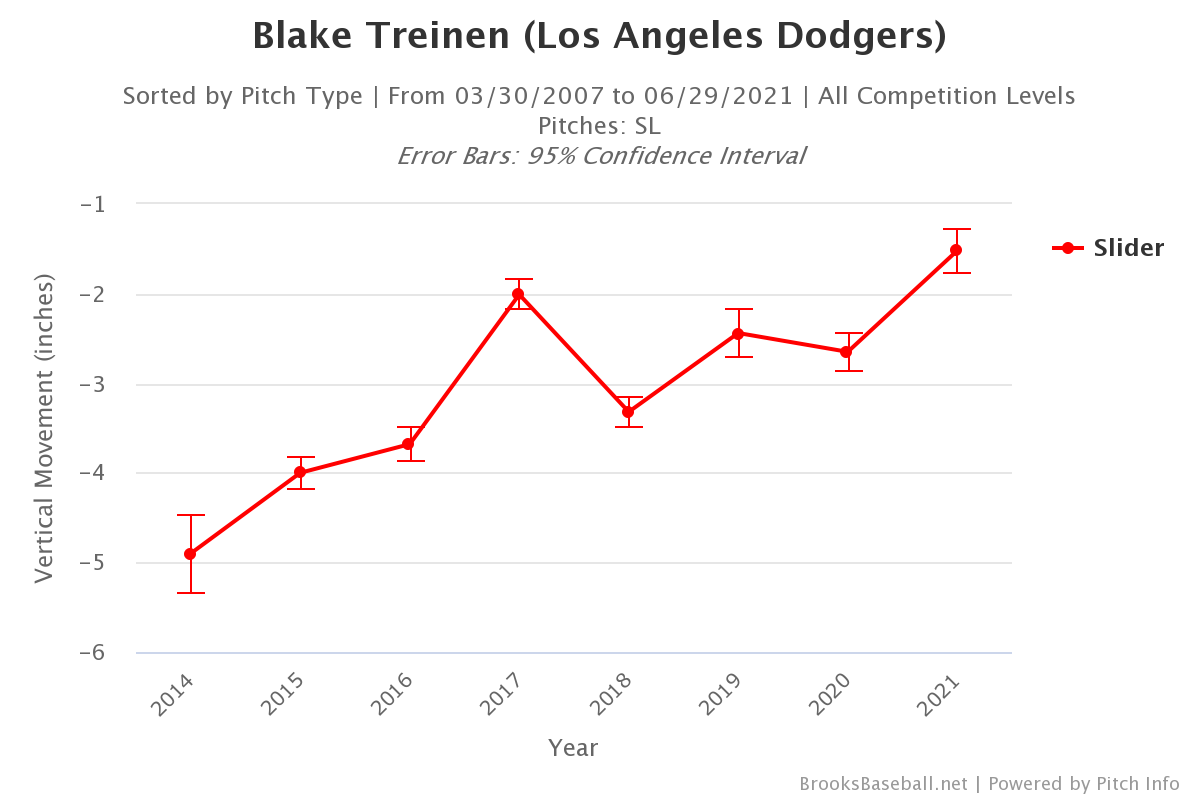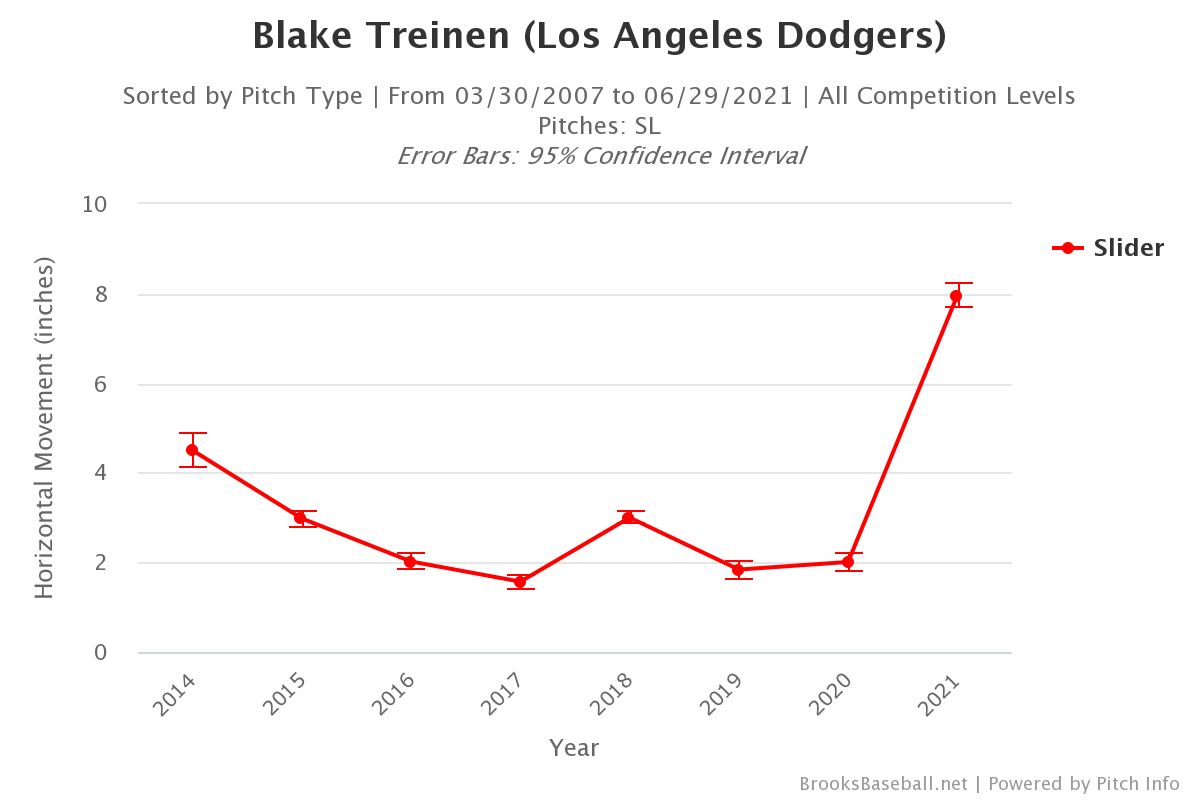(Stats as of 6/28)
In 2018, Blake Treinen had a breakout season for the Oakland Athletics where he threw 80.1 innings with a 0.78 ERA. He struck out 31.7% of hitters and was worth 3.6 fWAR. After a rocky 2019 season in Oakland, Treinen signed a deal with the Dodgers. His time in LA has been nothing short of underwhelming. However, this season he’s thrown 30.2 innings with a 3.23 ERA and a 28.1% strikeout rate. His 2.41 xERA and .247 xwOBA are both the 13th best among all pitchers. The deeper you dig, the closer the season seems to resemble his 2018 season, providing hope that his dominance in the past was not just a fluke.
Since 2018, nothing has changed within Treinen’s pitch arsenal—he still throws a sinker, slider, cutter, and 4-seam fastball. However, he has tinkered with his usage this season and it’s paying off thus far. For the last three seasons, Treinen has thrown his sinker mostly more than 50% of the time, but now he’s throwing it just 33.2% of the time. Where he’s stopped throwing his sinker he has mostly replaced it with his cutter.

For Treinen, this might have been the easiest adjustment he could have made, because his sinker is pretty bad. In 2018, the sinker fared well and it was decent the year after, but the past two seasons it has been down-right horrible. This season the pitch is finding a whiff only 17.6% of the time and hitters have a .396 wOBA against it. Sure, the xwOBA of .320 is a bit better, but the pitch just doesn’t garner enough swing and misses to make up the distance. But Treinen’s other pitches—mainly his slider and cutter—have been more than enough to yield him tons of success. His slider is finding a whiff more than half the time and holds hitters to a .122 xBA, .157 xSLG, and a .145 xwOBA. The same pitch holds a disgusting 41% CSW rate and is putting hitters away at rate of 31.5%. His slider posted nearly the same CSW rate back in 2018, but posted rates of just 25.5% and 31.7% in 2019 and 2020, respectively. Suprisingly, Treinen is throwing his slider slower than he has since 2015, but he’s yielding more movement on the pitch than ever before.


While his average vertical movement on his slider has been mostly increasing throughout his career, his horizontal movement this season is a new level of absurd—gaining nearly six inches of movement. Treinen is seeing massive gains in movement all while the league cracks down on the use of foreign substances, which makes me wonder if he is using an entirely new grip. Of course, he himself would be the best source, but based on how the pitch is spinning, it’s plausible. Last season his slider saw just 29% of active spin but this season it’s finding 41% of active spin. The pitch’s observed movement went from 7:15 to 8:45, a more horizontal rotation.
Along with his increased movement, Treinen is throwing this pitch to lefties more than he ever has, especially in the last three seasons. He still throws it more to right handed hitters, albeit facing more righty hitters, but lefties are struggling against it immensely. This nasty pitch is leaving lefties with just a .062 xBA and .156 xwOBA against it. He throws this pitch really well down and in to lefties. This is what it looks like.
https://gfycat.com/victorioustenderfawn
His cutter is his other solid pitch and the one that saw the biggest uptick in usage. It’s not nearly as dominant as the slider, but it’s still a really solid fastball, and one that he should probably continue to throw until it is his primary heater (seriously, drop the sinker). Treinen’s cutter is posting a 28.4% whiff rate, 30% put away rate, and a 33.6% CSW rate. Interestingly, his CSW rate this season is not his best. In 2018, the pitch posted a 35.8% rate and last season it posted a crazy 40% rate. Both CSW rates were carried by much better swing and miss rates. I’m unsure if this means the pitch has potential to fare even better than it currently is, or if it’s just the expected regression that may come with throwing the pitch way more often. Regardless, there’s enough evidence to say that his cutter is really good at finding strikes. Against the pitch, hitters carry a .202 xBA, .325 xSLG, and a .292 xwOBA, which are all very solid, but even more so when you compare it to the pitch that he could be throwing instead—his awful slider. The main takeaway isn’t that his cutter is good (it is), but the main point is that it’s a much better pitch than his primary fastball. And if Treinen continues to throw his cutter more often, it’s going to be a positive change. His cutter results in way more whiffs per swing, and although it results in less groundballs per ball in play by a good margin, it also results in a lot more flyballs per ball in play. And flyballs that stay in the ballpark, in almost every instance, are easier outs than ground balls, especially when they are hit weakly.
Speaking of weak contact, Treinen is in the 99th percentile of average exit velocity, 98th percentile of hard hit rate, and 98th percentile of barrel rate. Weak contact has been his best friend this season. It would be nice to see more strikeouts and whiffs overall, but Treinen has two pitches that are really, really, good. He’s found a borderline unhittable slider and a much improved sinker replacement. Treinen’s max potential may still be minimized if the continues to throw his sinker as often as he does without any adjustment, but where he stands with his slider and cutter, is a great place to be. Although he’s doing it a bit differently, Treinen is starting to look a lot more like the 2018 pitcher who led all relievers in ERA and fWAR.
Photo by David Dennis/Icon Sportswire
